| About me | Research | Contact |
Motion De-Blurring
If a camera moves fast while taking a picture, motion blur is induced. There exist techniques to prevent this effect to occur, such as moving the lens system or the CCD chip electro-mechanically. Another approach is to remove the motion blur after the images have been taken, using signal processing algorithms as post-processing techniques. For more than 30 years, numerous researchers have developed theories and algorithms for this purpose, which work quite well when applied to artificially blurred images. If one attempts to use those techniques to real world scenarios, they mostly fail miserably. In order to study why the known algorithms have problems to de-blur naturally blurred images we have built an experimental setup, which produces real blurred images with defined parameters in a controlled environment. On this page you will find a collection of de-blurring algorithms for you to study and motion blurred pictures in order to test your own algorithms.
Test Images
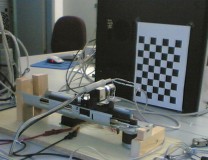 Our test images have been taken with a µC controlled camera, as shown in the picture on the left. The setup comprises a camera unit, a guiding rail and a stepper motor. The camera carriage is accelerated to a constant speed and takes a photo with a medium exposure time (around 100ms) to allow significant motion blur appear in the picture. As a starting motif a checkerboard structure has been chosen, since this allows an easy method for estimating the associated PSF. More details about the setup can be found in [1].
Our test images have been taken with a µC controlled camera, as shown in the picture on the left. The setup comprises a camera unit, a guiding rail and a stepper motor. The camera carriage is accelerated to a constant speed and takes a photo with a medium exposure time (around 100ms) to allow significant motion blur appear in the picture. As a starting motif a checkerboard structure has been chosen, since this allows an easy method for estimating the associated PSF. More details about the setup can be found in [1].
The following test images are available for deblur/download. They may be freely used for scientifc and non-commercial purpose. All other usage requires prior written permission by the owners.
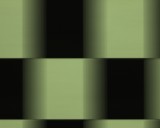 |
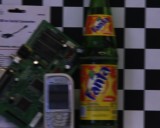 |
||
| File Size | Horizontal Displacement |
File Size | Horizontal Displacement |
| Large | a = 200px | Large | a = 200px |
| Medium | a = 100px | Medium | a = 100px |
| Small | a = 50px | Small | a = 50px |
If you are interessed in studying the differences between real and synthetic motion blur, we have created synthetic versions of the upper left image. The images were created using a Matlab script also available.
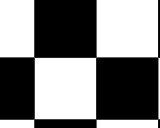 Unblurred reference image for comparision purposes |
 Blurred image with circular data wrap around |
||
| File Size | File Size | Horizontal Displacement |
|
| Large | Large | a = 100px | |
| Medium | Medium | a = 50px | |
| Small | Small | a = 25px | |
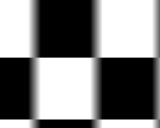 Blurred image with repetetive data wrap around |
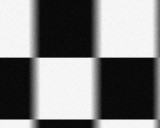 Blurred image with circular data wrap around and added noise (AWGN, var = 0.01) |
||
| File Size | Horizontal Displacement |
File Size | Horizontal Displacement |
| Large | a = 100px | Large | a = 100px |
| Medium | a = 50px | Medium | a = 50px |
| Small | a = 25px | Small | a = 25px |
Algorithms
So far, we know about the following de-blur algorithms. If you happen to know other algorithms we would be more than happy if you could email us.
| Name | Literature | Matlab command | Restoration Speed | Restoration Quality |
| Direct Approach | ||||
| Wiener Filter | deconvwnr (IPT) | |||
| Regularized Filer | deconvreg (IPT) | |||
| Richardson-Lucy Deconvolution | deconvlucy (IPT) | |||
| Maximum Likelihood Estimation | deconvblind (IPT) | |||
| TU Berlin | deconv_tuberlin | |||
| Sondhi | deconv_sondhi | |||
| Advanced Landweber | deconv_alm |
Note: Some Matlab commands might require the Image Processing Toolbox (IPT) by Mathworks.
Literature
| [1] | Comparison of Motion Deblur Algorithms and Real World Deployment, S. Schuon, K. Diepold, 2006, Paper on IAC 2006 (download as pdf) |
| [2] | Nature of Motion Blur, S. Schuon (download as pdf) |
Contact
- Sebastian Schuon, schuon (at) mytum (dot) de
- Klaus Diepold , kldi (at) tum (dot) de